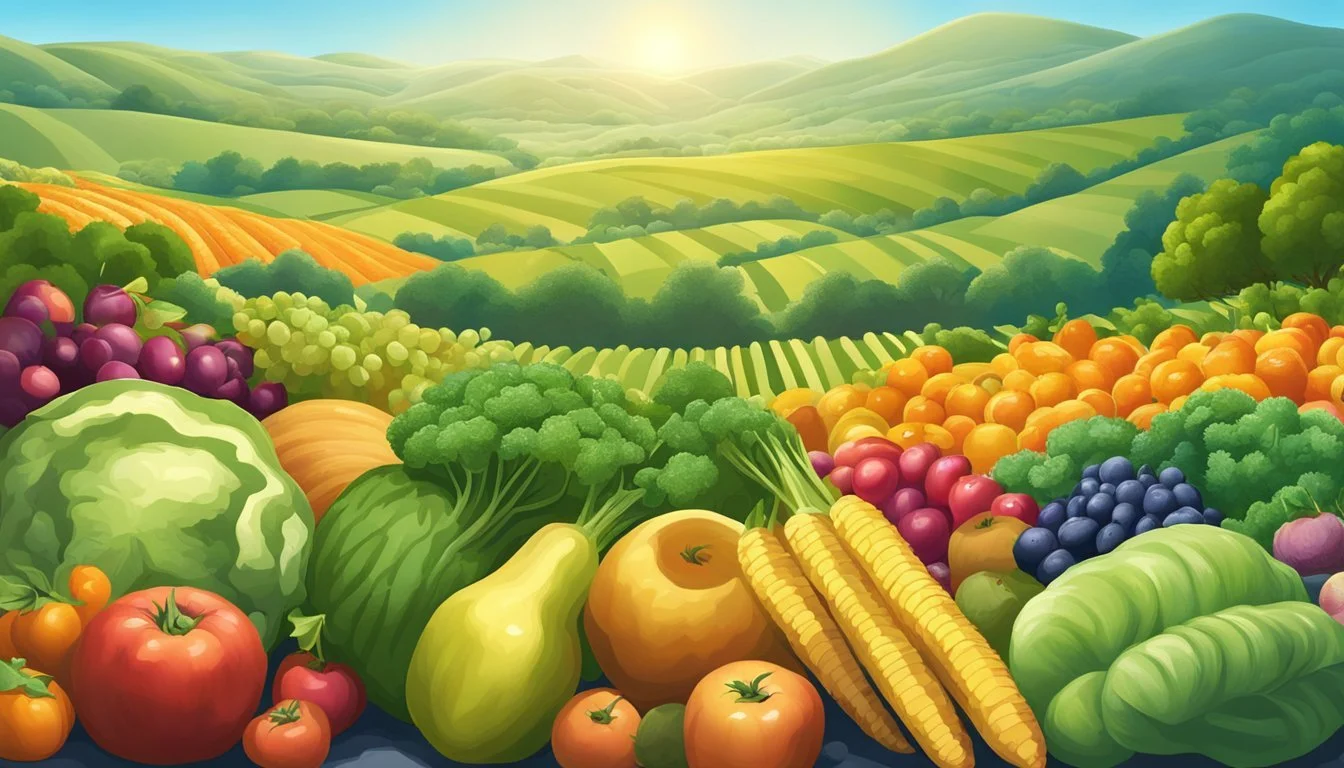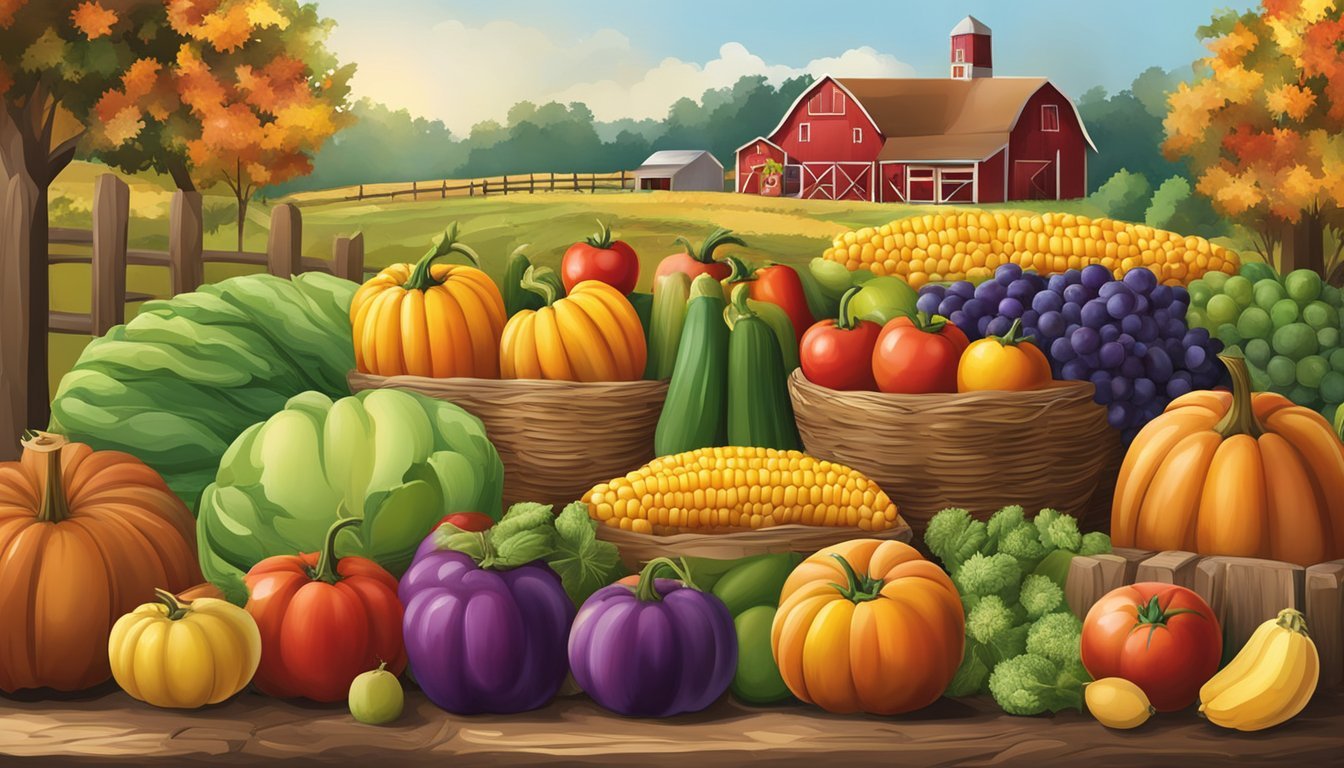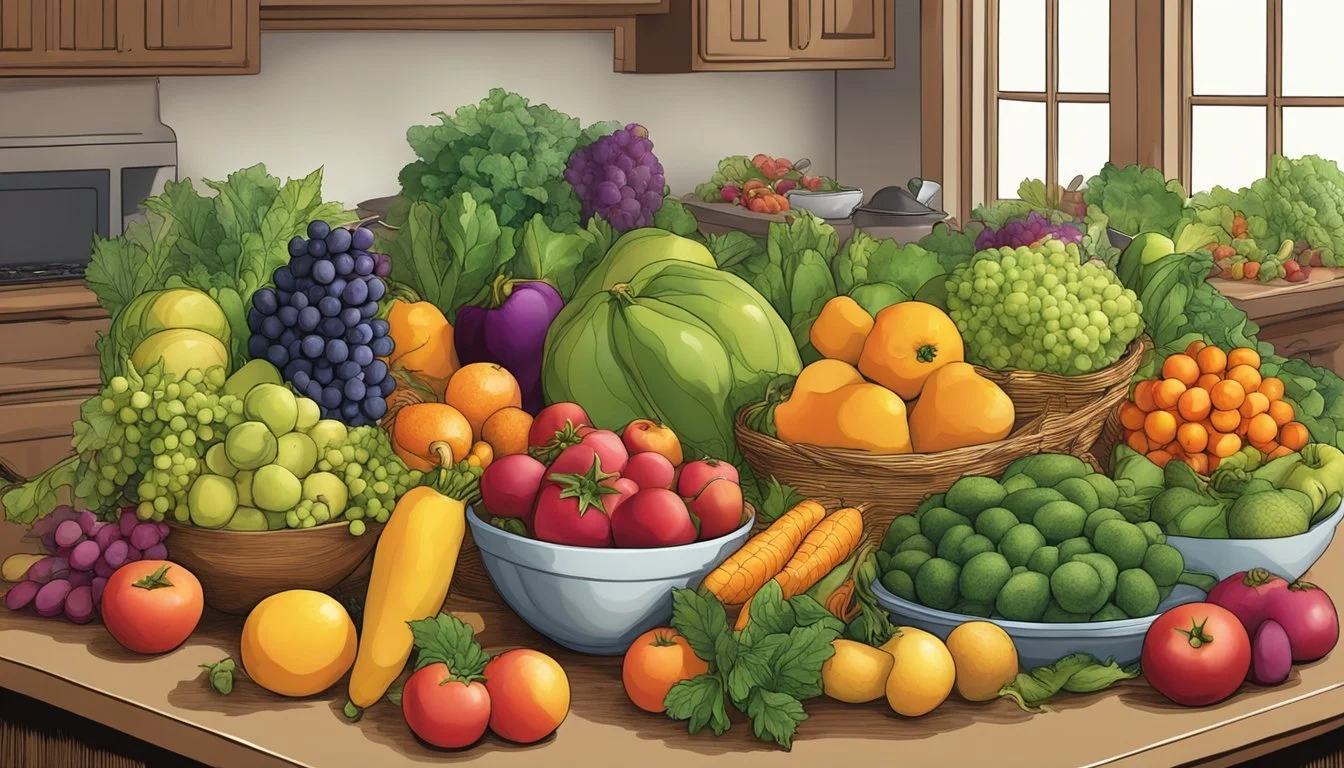Pennsylvania Seasonal Fruit & Veg Guide
Your Year-Round Companion
Embracing the cycle of the seasons, Pennsylvania offers a rich tapestry of fruits and vegetables that come into their prime at different times of the year. This guide illuminates the connection between the state's diverse agricultural offerings and seasonal availability. By understanding and utilizing a farm-to-table approach, consumers can enjoy produce at its peak of freshness and flavor, while supporting the local farming community and economy.
In Pennsylvania, the rhythm of the seasons dictates the ebb and flow of produce offerings. The summer months bask in the abundance of sweet peaches and juicy berries, while the arrival of fall brings a harvest of crisp apples and hearty root vegetables. Navigating through the months, chefs and home cooks alike can craft menus that reflect the state's regional and seasonal bounty.
Knowledge of the state's seasonal produce also underscores a commitment to sustainability, as locally sourced fruits and vegetables typically require less transportation and are harvested with an eye toward environmental stewardship. By choosing Pennsylvania-grown produce when it's in season, one also ensures a more nutritious and environmentally conscious choice, connecting the dots from the farm's soil to the dinner table.
What’s in Season in Pennsylvania Right Now?
Understanding Pennsylvania's Growing Seasons
Pennsylvania's diverse climate allows for a wide range of fruits and vegetables to flourish throughout the year, each season offering its distinct harvest. The state's agriculture thrives on a calendar that rotates with the seasons, bringing fresh produce to the tables of local enthusiasts and beyond.
Spring Harvest
In Pennsylvania, the spring harvest marks the beginning of the fresh produce season, where asparagus (What wine goes well with asparagus?) and strawberries start to peak. Gardeners and farmers eagerly anticipate the first bounty, which typically includes:
Asparagus: April through June
Strawberries: May through June
Radishes
Spinach
Summer Bounty
The summer months in Pennsylvania are a celebration of abundance. Peak season for many fruits and vegetables falls within this period. The warm weather and longer days contribute to a rich yield of:
Tomatoes: July through September
Corn: late July through September
Peaches: July through September
Blueberries: July through August
Zucchini
Green beans
Fall Harvest
As the state approaches the cooler days of fall, the harvest continues with robust flavors and hearty vegetables that define northeastern autumn. The fall harvest brings:
Apples: September through November
Pumpkins: September through October
Brussels sprouts (how long do brussels sprouts last?): September through November
Broccoli: June through November
Sweet potatoes
Cabbage
Winter Offerings
Even in winter, Pennsylvania's agriculture does not come to a standstill. Root vegetables and certain greens can survive the chill and are often available:
Kale: available from storage, peak season is summer to fall
Potatoes: available from storage, harvested in summer and fall
Carrots: available from storage, harvested in summer and fall
Indoor grown produce like lettuce and microgreens
The state's determination to provide a year-round supply of local produce makes the Pennsylvania farm-to-table experience truly unique, offering fresh, in-season produce at its peak quality and flavor.
Monthly Guide to Pennsylvania Produce
This section provides a detailed look at the fruits and vegetables available in Pennsylvania throughout the year, helping residents and visitors enjoy the freshest local produce in each season.
January to March
During the cold early months, Pennsylvania offers storage crops and hearty vegetables that can withstand the chill. Consumers can find:
Apples: Stored from fall harvest
Potatoes: A staple storage crop
Onions: Available from storage
Carrots: Often from cold storage
Mushrooms: Grown year-round
April to June
As spring arrives, Pennsylvania begins to see a greater variety of fresh produce. This period marks the arrival of:
Asparagus: Peaking in May
Strawberries: Coming into season in June
Lettuce: Thriving in the cool spring
Radishes: Quick to harvest in April and beyond
Herbs: Such as parsley and cilantro, starting in late spring
July to September
Summer brings a bounty of Pennsylvania produce, with fruits and vegetables at their peak:
Tomatoes: Ripe and plentiful in July and August
Sweet Corn: A summer favorite, best from July to September
Blueberries: Available in July
Peaches: Ripening in July and August
Zucchini & Summer Squash: Abundant throughout the summer
October to December
Fall in Pennsylvania offers a new range of produce as the harvest season winds down:
Pumpkins: Symbolic of October and the fall season
Apples: Late-season varieties picked in October
Brussels Sprouts: Sweeter after the first frost, often available until December
Cranberries: October marks the start of cranberry season
Pears: Harvested in early fall and often available into December
By seeking out in-season produce, Pennsylvanians can enjoy the freshest flavors while supporting local agriculture.
Selecting and Storing Pennsylvania Produce
Selecting fresh produce at its peak and understanding proper storage methods are essential for enjoying the best flavors and nutritional benefits. Pennsylvania offers a wide range of fruits and vegetables, each with its own selection criteria and storage needs.
Fruit Selection Tips
When selecting fruit in Pennsylvania, one should look for indicators of peak ripeness and freshness. Here are some specific tips:
Apples: Firm and free of bruises. They will last up to three weeks when stored in a cool, dark place.
Peaches: Should give slightly to the touch and have a fragrant aroma. Refrigerate ripe peaches immediately and eat within 3-5 days.
Blueberries: Look for plump, dark blue berries with a silvery bloom. Keep them in the refrigerator for up to a week.
Vegetable Selection Tips
Choosing vegetables at their best requires attention to detail. Consider the following:
Tomatoes: Should be brightly colored and firm with a slight give. Store at room temperature away from direct sunlight.
Leafy Greens: Look for vibrant, crisp leaves. Store unwashed in the refrigerator in a perforated bag for up to a week.
Root Vegetables: Firm and free of soft spots. Most root vegetables like carrots and potatoes should be stored in a cool, dark, and well-ventilated area.
Preservation Techniques
Proper preservation extends the life of Pennsylvania’s produce while maintaining freshness. Here are common techniques:
Freezing: Fruits like berries can be frozen on a baking sheet before transferring to an airtight container, perfect for year-round smoothies.
Canning: Tomatoes and apples can be canned in various forms such as sauces or jams to capture their flavors well after the season.
Storage: Most produce can be kept in the refrigerator, but certain items like onions and potatoes prefer a cool, dark place. Always use airtight containers or proper ventilation when needed.
By following these tips, one can enjoy the delicious bounty of Pennsylvania year-round.
Top Pennsylvania Produce Picks
Pennsylvania's climate and fertile soil contribute to a diverse and flavorful bounty of produce. This region's offerings vary by season, ensuring that local markets are stocked with fresh fruits and vegetables throughout the year.
Favorite Fruits
Peaches: They are a summertime favorite, with the season peaking in July and August. Juicy and sweet, Pennsylvania peaches are ideal for baking or enjoying fresh.
Apples: A fall staple, available from late summer through fall. Varieties like McIntosh and Red Delicious are perfect for both eating raw and cooking.
Berries: Strawberries herald the start of berry season in June, followed by blueberries, blackberries, and raspberries, which continue through late summer.
Cherries: Both sweet and tart cherries are harvested in June and July. They are often celebrated in regional festivals and are a treat eaten fresh or baked into pies.
Grapes: Vineyards thrive in Pennsylvania, yielding grapes from late summer to early fall, which are excellent for fresh eating, juices, and wines.
Favorite Vegetables
Tomatoes and Cucumbers: Summer favorites that are widely available from late July to September, perfect for salads and sandwiches.
Leafy Greens: Spinach, kale, and lettuce are available in the spring and again in the fall.
Corn: Sweet corn is a Pennsylvania highlight from July to September, synonymous with summer cookouts and county fairs.
Root Vegetables: Potatoes, carrots, beets, and turnips thrive in cooler months. Many are stored and available well into winter.
Winter Squash and Pumpkins: Harvested in the fall, they are known for their versatility and storage capabilities, featuring prominently in both savory and sweet autumnal dishes.
Brassicas: Broccoli, cabbage, and Brussels sprouts are cool-weather crops that are typically available from late summer through late fall.
Alliums: Garlic and onions, both essential flavoring agents, are harvested in summer and stored for use throughout the year.
This guide provides a snapshot of the top fruits and vegetables found in Pennsylvania, reflecting the state's rich agricultural tradition.
Supporting Local Pennsylvania Farmers
Supporting local Pennsylvania farmers not only contributes to the state's economy but ensures that consumers have access to fresh and seasonal produce. There are several structured ways for consumers to engage with local agriculture.
Farmers Market Guide
In Pennsylvania, farmers markets serve as a key point of purchase for fresh, local produce directly from the growers. These markets provide an opportunity for consumers to buy seasonal fruits and vegetables at the peak of freshness and flavor. Consumers are encouraged to invest a little more in local produce, which supports healthy communities and the state’s economy.
Invest Locally: Aim to spend at least an additional $10 a month on local produce to bolster Pennsylvania's agricultural base.
Community-Supported Agriculture (CSA)
Community-Supported Agriculture programs in Pennsylvania offer consumers a chance to buy "shares" from local farmers. These shares typically consist of a box of seasonal vegetables and can also include other farm products. For over 25 years, CSAs have enabled direct support of local farmers while providing consumers with regular deliveries of fresh produce.
CSA Shares: Purchase a share in a farm’s harvest for a regular supply of fresh produce throughout the growing season.
Incorporating Seasonal Produce into Meals
In Pennsylvania, using seasonal produce in meals not only highlights the freshest flavors available but also supports the local agriculture. Chefs and home cooks alike can enhance their dishes by featuring fruits and vegetables at the peak of their season.
Seasonal Recipes
Pennsylvania's diverse seasons offer an array of fruits and vegetables that can be transformed into delicious recipes. During the spring, ramps and asparagus stir a buzz in kitchens, leading to dishes like Asparagus Risotto or Ramp Pesto Pasta. Summer brings a bounty of berries and stone fruits, perfect for making a vibrant Peach Cobbler or a refreshing Blackberry Salad. In the autumn, apples and pumpkins take center stage, inspiring creations such as Apple Cider Braised Pork and Roasted Pumpkin Soup. Winter's hearty root vegetables and squashes lend themselves to warm comfort foods, such as Butternut Squash Mac & Cheese and Roasted Root Vegetable Medley.
Blog Inspiration
Culinary blogs often serve as an excellent source of inspiration for incorporating seasonal produce into meals. They showcase current trends in food preparation and provide step-by-step guidance on how to highlight a season's offerings. For example, a blog might feature a post on Summer Vegetables that teaches readers how to make a Grilled Corn and Zucchini Salad. Meanwhile, a winter-themed entry could focus on how to select the best Root Vegetables for a Hearty Winter Stew, complete with vivid photography and tips on roasting techniques.
By tapping into such resources, individuals can find a wealth of ideas that demonstrate how to select, prepare, and enjoy Pennsylvania's seasonal fruits and vegetables to their fullest.
The Economic Impact of Seasonal Farming
Seasonal farming contributes significantly to the economy of Pennsylvania. Through a data-driven approach, entities like Penn State Extension have demonstrated the value of this sector.
Local Economy
Seasonal farming bolsters the local economy by supporting jobs in the agricultural sector and related industries. Pennsylvania agriculture sustains jobs and generates billions in economic impact annually. For instance, for every dollar of direct farm output, an additional $0.63 is contributed to the economy, highlighting the multiplier effect. Local markets driven by farm-to-table demands provide farmers with more profitability options, ensuring that the financial benefits remain in the community.
Number of Jobs Supported: 590,000+
Annual Economic Impact: $132.5 billion
Income Generated: Farming provides a stable source of income for local families, reinforcing the economic structure of rural areas.
Sustainable Farming Practices
Sustainable farming practices introduced and supported by organizations, including Penn State Extension, further enhance the economic value by promoting efficient use of resources and mitigating environmental impacts. They lead to cost savings for farmers, through reduced inputs, and help to maintain the long-term viability of farms.
Resource Efficiency: Farmers employing sustainable methods optimize the use of water and soil, leading to better yields and reduced expenses over time.
Environmental Conservation: Sustainable practices help to conserve biodiversity, contributing to the continued bounty of produce available in the state.
Public Awareness: Enhanced public education on sustainable farming practices leads to increased consumer demand for responsibly grown produce, thereby supporting Pennsylvania's agriculture sector economically.









